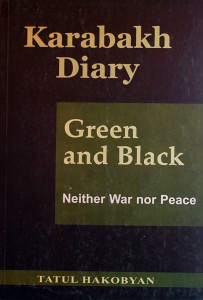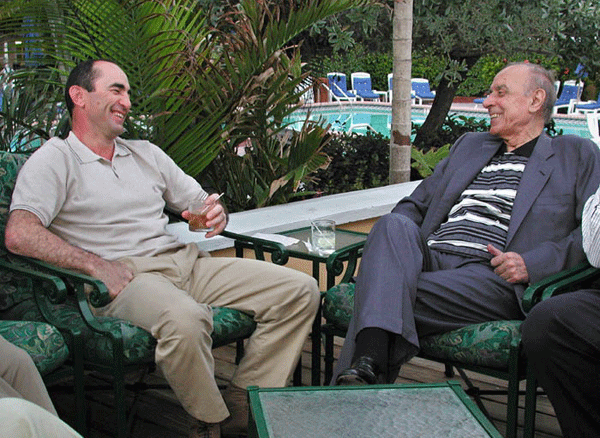This piece is from KARABAKH DIARY: BLACK and GREEN volume
Stepanakert-Baku direct contact
During the war years, Armenia was trying to show the international community that the conflict was between NK and Azerbaijan. How well it succeeded is a different question. But the fact remains that until 1997 NK was a military-political reality with which Baku had to come to terms, especially after the failures in the battle field. Whenever Azerbaijan was forced to enter into direct communication with NK, Baku preferred keeping it secret, so that the international community and Armenia would not consider such moves as a tacit indication to even indirectly recognizing NK.
The first direct contacts between Stepanakert and Baku took place on September 15, 1992, in Moscow. The meeting was between Hikmet Hajizade, Azerbaijan’s Ambassador in Russia, and Arakdy Ghukasyan, an advisor to Robert Kocharyan, Chairman of the State Defense Committee, In mid April 1993, again in Moscow, Hajizade, Davis Shahnazaryan and Ghukasyan held a discussion on the ceasefire behind closed doors.
Russia encouraged Azerbaijan to establish direct contacts with NK, a proposal which Baku approached unwillingly. However, failures on the military front were enough for Azerbaijan to communicate with NKR’s authorities without even informing Russia. From this point of view, Heydar Aliyev was the most constructive, especially in the summer of 1993, when peace was as necessary to him as air and water in terms of consolidating his authority.
As Kazimirov writes, the first telephone conversation took place on June 27, 1993. Safar Abiyev called Serge Sargsyan in Stepanakert. On the day following the loss of Aghdam, there were telephone conversations between Abiyev and Karen Baburyan, as well as Abiyev and Babayan. A three day ceasefire agreement was reached. The sides recorded the agreement on paper and faxed it to each other.
Azerbaijani high-ranking officials referred to their colleagues in NK in different ways. Thus, Abliyev sent the first fax addressed to Baburyan, signing it thus, “Armenia’s Supreme Council, to Mr. Baburyan”. In the fax replying from Stepanakert it is written that in the upcoming three days an agreement will be reached “during the meeting of Azerbaijan’s and Nagorno-Karabakh’s leaders”. On July 25, in a fax sent to Babayan, Abiyev uses other words, “Nagorno-Karabakh’s Defense Ministry, to Army Commander Babayan”.
The meeting between the NK and Azerbaijan officials, headed by Abiyev and Sargsyan, took place on July 28, in the Martakert sector. During the negotiations it was decided to extend the ceasefire and settle the issue of military hostages and other issues of mutual interest. After returning to Stepanakert and Baku, once again via fax, the document on extending the ceasefire (called an ‘agreement’) was signed. Under Abiyev’s and Sargsyan’s signatures, the words “on the part of Azerbaijan” and “on the part of Nagorno-Karabakh” were printed respectively.
On August 4, 1993, Abiyev, who, after the signing of the May 1994 ceasefire became the most bellicose of Azerbaijani officials, sent the next fax to “Nagorno-Karabakh Defense Minister Serge Sargsyan”, suggesting extending the ceasefire agreement for another ten days and preparing for the “meeting between the leaders of Azerbaijan and Nagorno-Karabakh”.
In September of the same year, when Baku had already lost six regions, Heydar Aliyev authorized Afiyaddin Jalilov, the Deputy Speaker of the Parliament, “to carry out negotiations for organizing a meeting between the leaders of Azerbaijan and NKR”. After reading the ‘NKR’ abbreviation, Kazimirov immediately called and informed Aliyev about the superfluous letter ‘R’. A short while later, the Russian mediator received a new document, via fax, which only had ‘NK’ written on it. The incorrect fax bearing ‘NKR’ had already been sent to Stepanakert, but the Karabakh leadership did not exploit the oversight.
On September 12-13, a meeting between Jalilov and Ghukasyan took place at the Russian Foreign Ministry. As a result of the negotiations, a joint memorandum was adopted. The sides agreed to a ceasefire until October 5. The ceasefire was maintained and extended for another month, but military actions resumed on October 21. Thus, the ceasefire was in effect for fifty whole days.
On September 25, negotiations between Ter-Petrosyan and Aliyev, and later that day a confidential meeting between Aliyev and Kocharyan took place in Moscow. “We were preparing for that meeting secretly. At that time the minor intrigues of our western colleagues began. Knowing that a similar meeting was foreseen in Moscow, they organized a Minsk Group meeting in Paris during those days. I was only present at the last moments of the Kocharyan-Aliyev meeting. Later, Kocharian told me that an agreement had been reached to continue the meetings,” says Kazimirov.
After the May 1994 ceasefire, Kazimirov suggested to Aliyev to resume the confidential meetings with Kocharyan on six separate occasions. “Each time, after agreeing in principle, Aliyev would raise the argument that the Armenians were exploiting it for propaganda purposes. I would say that I’d try to get a written promise from Kocharyan not to go public. I drafted such a note and sent it to Kocharyan and Aliyev. Kocharyan answered that he was ready to sign it if Aliyev did. But Aliyev did not sign. I talked about a bilateral meeting six times and on the seventh and eighth times, Aliyev initiated the conversation himself. And so, we agreed eight times”, recalls Kazimirov with humor.
During Aliyev’s rule Azerbaijan lost five districts – all of Jebrail, Ghubatlu and Zangelan, and Aghdam and Fizuly, partially. But he was no less worried about strengthening his position in Baku. On August 29, a referendum declaring a vote of no confidence in Elchibey took place. Elchibey, who had moved to his birthplace, the village of Keleki, announced that he did not accept the rigged results of the referendum and that he would struggle using democratic methods “to eliminate the results and consequences of the coup”. Snap presidential elections took place on October 3. Aliyev garnered an absolute majority of the votes.
Photo – Kocharyan and Aliyev in 2001, in Key West, Florida
 An exceptional and informative work based on a rich and varied source base. Its impartiality is striking. A much needed monograph destined to persevere as the ‘textbook’ for Armenian diplomacy. As a pioneering initiative that presents an accurate reinterpretation of the Karabakh struggle for self-determination, this book captures the essence of the issue with an illuminating portrayal of many of the key figures and events that have come to define the Karabakh issue. The conflict cruelly shaped the destinies of thousands of average people and the ordeals they bore underline the responsibility of those at the top, in whose hands a resolution of the Karabakh conflict rests. The author’s secret, revealed in the pages of Green and Black, is that he does not shy away from presenting those facts and realties no longer considered expedient to remember. Anyone wishing to be informed and regarding the Karabakh conflict must read this book.
An exceptional and informative work based on a rich and varied source base. Its impartiality is striking. A much needed monograph destined to persevere as the ‘textbook’ for Armenian diplomacy. As a pioneering initiative that presents an accurate reinterpretation of the Karabakh struggle for self-determination, this book captures the essence of the issue with an illuminating portrayal of many of the key figures and events that have come to define the Karabakh issue. The conflict cruelly shaped the destinies of thousands of average people and the ordeals they bore underline the responsibility of those at the top, in whose hands a resolution of the Karabakh conflict rests. The author’s secret, revealed in the pages of Green and Black, is that he does not shy away from presenting those facts and realties no longer considered expedient to remember. Anyone wishing to be informed and regarding the Karabakh conflict must read this book.
Paperback: 416 pages,
Language: English,
2010, Antelias,
ISBN 978-995301816-4.














